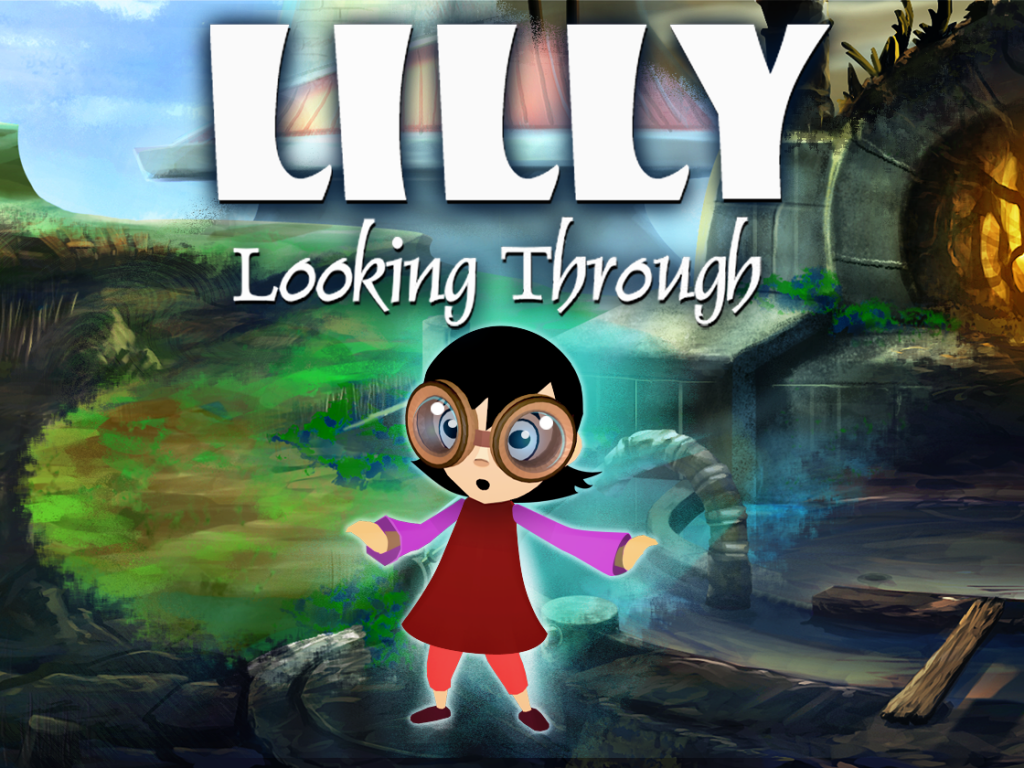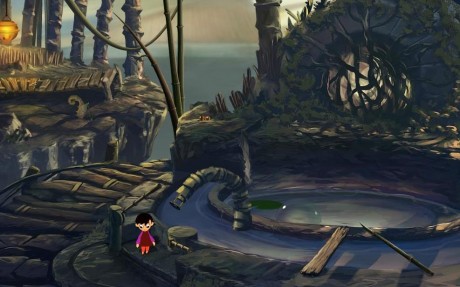Lilly Looking Through is one of the most wonderful games we’ve seen lately, with a very promising demo that puts you inside two parallel worlds of magnificence and mystery. On this Monday’s interview, we meet the creator of Lilly Looking Through, Steve Hoogendyk and try to learn as much as possible about Lilly and indie games development. Enjoy…
Why did you decide to stop working for company game development studios and the filming industry to start an indie game project?
For many years Jessica and I have wanted to create our own point and click adventure game. We also, wanted to move closer to family, now that we have 2 little girls of our own. We also wanted to live less of a nomadic life. Moving after every film project was completed was becoming difficult. So we moved back to my home town, and realized now would be the perfect time to pursue our dream of creating an original adventure game.
Is this an one time thing because something inside you couldn’t be limited and formed according to the marketing laws of profit, or a complete change of the way you believe your games should be created and distributed?
This year we officially became Geeta Games, and our goal is to continue to create adventure games. Being a small indie game studio buys us the freedom to pursue projects we are really passionate about. In the last few years, development of adventure games at the larger gaming studios have really vanished. We feel like this gives smaller game studios, like ourselves, a space to fill this gap and create an adventure game that couldn’t be, or wouldn’t be, created at a larger studio for a variety of reasons.
Everything in life likes to change. We see that the way people play games, get media, and interact with each other has adapted rapidly in the last 10 years. In the 90’s you had to get a publisher just to get your game into stores. Now thanks to Amazon, Netflix, Facebook, downloadable apps, and Kickstarter we have a variety of ways to market, sell, and distribute digital media. We embrace the change and see all of this as a wonderful opportunity for small indie game studios.
Lastly, our team members can more easily than ever work and collaborate remotely. I can skype with other team members and share game assets in the cloud.
Is it more difficult for an indie game developer to create games when not under the wing of a company (stable salary, direct collaboration with other departments, specific workload and timetables), or is it easier because the only limitations are your skills and imagination?
We have total freedom to bring a unique story to gamers without the corporate machine that a AAA tile must answer to or endure
Creatively Yes. We have total freedom to bring a unique story to gamers and can make concise decisions without all the red tape of a larger studio. We get to create a game that we ourselves would love to play. This lets us pour in all our passion and make the best game possible.
Financially the stakes definitely feel higher when you are an indie developer. Financing a project with all your savings is always scary. However, it is also incredibly exciting to pursue your dreams, and we think that outweighs the risks.
We do believe that we are only limited by our skills and imagination as well as bandwidth. Limitations are a good thing if you think of them as the framework to play in. We’ve been very diligent about defining the scope of “Lilly Looking Through” so that it’s a project we can actually complete. This also lets us be more innovative and creative within the parameters we’ve defined for the game.

Inspiration is a funny thing because it can be found almost anywhere. I am really inspired when I step away from the computer and recharge by going outside and just observing our world. It’s a real wonder to behold and its always amazing to me how quickly we take it for granted. The sheer beauty of our world really inspired us when we laid the groundwork for the world that Lilly lives in. In some ways, it is similar to our world, but with a few elements significantly changed. I often see things outside and wonder “what if this …was larger, smaller, slowed down, sped up…”
I remember in high school going to the libray during study hall and finding a book with Leonardo da Vinci’s sketches and designs.The idea that an artist could be so good at art and mechanics just fascinated with me.
Other films and games which have no doubt inspired the world of Lilly are Myazaki’s films and the adventure game Myst.
What is it that you like most in point and click adventure games?
Magic. Mystery. Marvelous machines.
All of these are in our game “Lilly Looking Through.”
Point and Click adventure games combine everything I enjoy about great entertainment. An adventure game isn’t only a passive story that you watch. It’s an immersive story that demands you interact and participate. As well, an adventure game is filled with wonderful environments and mystery which satisfy my love of exploration. Often adventure games are filled with opportunities to creatively solve seemingly impossible challenges. Playing adventure games gives me great satisfaction.
From the creators point of view, is it easy to achieve the encapsulation of your feelings inside a game, while in the same time taking care of stimulating the feelings of the player? Is this something that comes naturally through the creation itself?
Definitely. It’s a form of communication that I naturally move towards.
When I was working at Disney the famous writer Ray Bradbury came in to give a talk. One of the things he said that really resonated with me was “Whatever you do, never forget your first love.”
When you commit to doing something you love it gives you all the motivation to continue to create, especially when you hit hurdles on a project. While we were developing “Lilly Looking Through” we had just a few key ideas that developed the framework for the game. The more we lived in Lilly’s world and worked on it, the more it told us what it needed to be. In a way it feels like Lilly and her world are real, and have taken on a life of their own.
Adventure games and puzzles are two interrelated things. Where do you find the inspiration for puzzle creation?
I always start with the story and the world that Lilly lives in. Where will the adventure take her and what will it look like? After the line art of an environment is roughed in with the large puzzles in place, I look at it again from a different perspective. I almost live in the world and imagine what it would feel like, and let my mind explore the “what ifs” that I see. Sometimes a particular element in the environment that was placed in just for visual interest can become another part of the larger puzzle. I think of it in phases, like a painter creating a landscape. They roughly fill in the composition and slowly increase the detail and enhance the beauty of the landscape. Certain areas get more embellishment and others are just hinted at. I allow myself to make changes if it ultimately makes the game and puzzles better.
Is puzzle making a talent related thing, or a carefully designed piece of mind entertainment?
I would say puzzle making is both talent related and carefully designed, with one half creative talent and one half persistence. Also, the harder you work at something you inherently love, the better you are bound to get at it.
If puzzles are too easy, gamers complain and if they are too difficult they are unsolvable. How can the creator achieve the “golden mean” on this sector of game designing?
It’s a balancing act of design inspiration and perspiration (plain old hard work).
We always do some game play to see how players solve the puzzles. This gives us valuable insight on how tweak a puzzle to the fullest extent and hopefully find the “golden mean.”
The puzzles in the “Lilly Looking Through” are designed in a specific order to be building blocks for more advanced puzzles that appear later in the game. Observation is critical to solving these puzzles, and like any good primer, we are really defining the rules of Lilly’s world. Lilly and the player will learn from the initial puzzles, and build on them to solve the more advanced puzzles discovered later in the game.
I also try to look at it from the player’s perspective, and try to see how they will experience the world looking at it for the first time. It’s a big responsibility to ask the player to agree to suspend their disbelief and go along on this ride. It takes time to build the trust between the designer and player and its something I take pretty seriously. This game is entertainment after all, and if people don’t enjoy it, and don’t complete the game, we have failed.
We’ve also created a safety net where the player can hit the “ ? ” button and receive a hint to help progress in the game.
Not many game developers decide to spend time to port their games to the Linux platform. What was your motivation?
The Linux community is awesome! It feels like a community of people who really want to share knowledge and tools with each other.
Jessica and I both worked in film for a number of years and all the studios use some flavor of Linux. So we are pretty comfortable in that environment.
I also think it’s healthy to have more than 2 “defacto” operating systems in the world. We want to bring “Lilly Looking Through” to as many people on planet earth as possible, and we don’t want people to miss out just because they don’t have a specific operating system.
Do you use any open source tools for the creation of LLT?
The Starling Framework and Adobe Flex are the open source tools we’ve been primarily using.
What would you say is the most difficult thing in the creation of a point n click adventure game? Also, what advice would you give to young creative people who want to start developing their own indie game?
Initially its committing to one idea. The biggest challenge is finding an idea that you are really in love with. If you aren’t in love with the project you will probably not follow through and finish it. Especially when the project becomes difficult to work on for a variety of reasons.
Start small. You can always make a game idea really complicated. The challenge is pairing your ideas down to the one or two things you are most excited about. If you don’t have an idea for making a game, find other people locally or on the internet who share your passion and make a game together.
Experience is invaluable. So if you really want to make a game then do whatever you can to learn from others around you. And play games! Figure out what you like about your favorite games, and examine why you like it.
For my first game job, I remember telling Presto Studios that I would work for them for free for six months, and if they didn’t like me they could fire me. They hired me, and thankfully according to California State law they had to pay me as well. Persistence is key.
Can you say anything regarding the game price and release date?
We haven’t announced an official release date or game price, but once the project nears completion we will be shouting it from the rooftops.
One thing worth mentioning is that we May 29th we will be launching a kickstarter project. One of the hurdles of being a small indie game studio is funding. We would like to add a few members to the Geeta Games team to finish “Lilly Looking Through” in half the time. To do this we are going to be doing a kickstarter project in hopes of raising $18,000 during the month of June. The funds would then be used to pay the additional team members, so they can commit the time needed to help us finish “Lilly Looking Through” in record time.
If you are interested you can check out our Kickstarter page!
Any future games already taking form inside your head?
Yes, I’ve a few fun ideas, but right now we are so focused on “Lilly Looking Through” that that consumes most of my time. So for now they are just seeds germinating and haven’t become fully formed game ideas.







